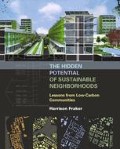Abstract
The four European case studies and the first American example of a zero net energy neighborhood demonstrate the feasibility of attaining low- to no-carbon and 100 percent renewable energy operations. They illustrate the value added by designing for sustainability at the neighborhood or district scale, in contrast to the building scale or large utility scale. The neighborhood is the in-between scale, the unit so important to city building. It provides not only the conveniences of everyday life but also a sense of identity and belonging. It is so often the neighborhoods that give cities their defining qualities.
Rights and permissions
Copyright information
© 2013 Harrison Fraker
About this chapter
Cite this chapter
Fraker, H. (2013). Conclusion. In: The Hidden Potential of Sustainable Neighborhoods. Island Press, Washington, DC. https://doi.org/10.5822/978-1-61091-409-3_8
Download citation
DOI: https://doi.org/10.5822/978-1-61091-409-3_8
Publisher Name: Island Press, Washington, DC
Print ISBN: 978-1-59726-368-9
Online ISBN: 978-1-61091-409-3
eBook Packages: Earth and Environmental ScienceEarth and Environmental Science (R0)

